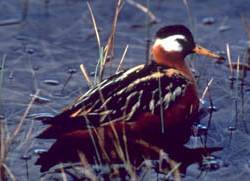Red Phalarope (Phalaropus fulicaria) - wiki Red Phalarope
From Wikipedia, the free encyclopedia
[Photo] Red Phalorope from US Forestry Service. Source: Cordova Ranger District, U.S. Forest Service
The Red Phalarope (called Grey Phalarope in Europe), Phalaropus fulicaria, is a small wader. This phalarope breeds in the Arctic regions of North America and Eurasia. It is migratory, and, unusually for a wader, migrating mainly on oceanic routes and wintering at sea on tropical oceans.
Red Phalarope is about 21 cm (8 inches) in length, with lobed toes and a straight bill, somewhat thicker than that of Red-necked Phalarope. The breeding female is predominantly dark brown and black above, with red underparts and white cheek patches. The bill is yellow, tipped black. The breeding male is a duller version of the female. Young birds are light grey and brown above, with buff underparts and a dark patch through the eye. In winter, the plumage is essentially grey above and white below, but the black eyepatch is always present. The bill is black in winter. Their call is a short beek.
The typical avian sex roles are reversed in the three phalarope species. Females are larger and more brightly coloured than males. The females pursue males, compete for nesting territory, and will aggressively defend their nests and chosen mates. Once the females lay their olive-brown eggs, they begin their southward migration, leaving the males to incubate the eggs and care for the young. Three to six eggs are laid in a ground nest near water. The young mainly feed themselves and are able to fly within 18 days of birth.
When feeding, a Red Phalarope will often swim in a small, rapid circle, forming a small whirlpool. This behaviour is thought to aid feeding by raising food from the bottom of shallow water. The bird will reach into the outskirts of the vortex with its bill, plucking small insects or crustaceans caught up therein. They sometimes fly up to catch insects in flight. On the open ocean, they are found in areas where converging ocean currents produce upwellings and are often found near groups of whales. Outside of the nesting season, they often travel in flocks.
This species is often very tame and approachable.
The Red Phalarope is one of the species to which the Agreement on the Conservation of African-Eurasian Migratory Waterbirds (AEWA) applies.
http://en.wikipedia.org/wiki/Red_Phalarope
| The text in this page is based on the copyrighted Wikipedia article shown in above URL. It is used under the GNU Free Documentation License. You may redistribute it, verbatim or modified, providing that you comply with the terms of the GFDL. |
